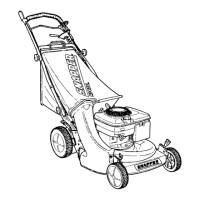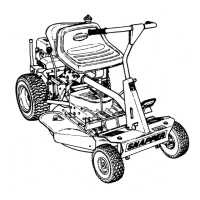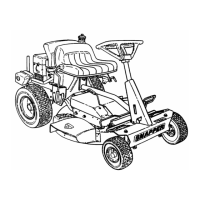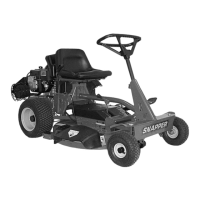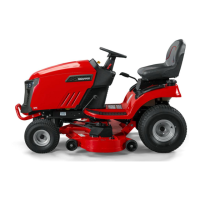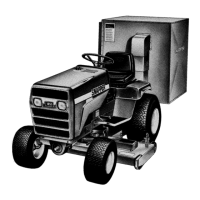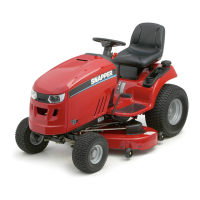Maintenance(Continued)
BatteryService
New BatteryPreparation
1. Remove the battery from the carton.
2. Placethe battery in a well ventilated areaon a level non-
concrete surface.
3. Remove the battery cell caps. Fill the cells as required
with electrolyte (supplied with battery) to the proper
level. Fillingthe battery with electrolyte will bring the
battery to 80% charged state.
4. With the cell caps removed, connect the battery charger
to the battery terminals; REDto positive (+) and BLACK
to negative(-) terminal.
IMPORTANT:Neverplace anything in the battery other than
the specified electrolyte.
5. Slow charge the battery at 1 amp for 2 hours to bring
the battery to full charge.
6. After charging, check the level of electrolyte and add as
neededto bring to the proper fluid level.
7. Reinstall the cell caps.
8. Install the battery into the power unit.
9. Connect the positive (+) cable (red) first, from the wiring
harness to the positive terminal (+) on the battery using
the bolt and nut provided in the hardwarebag. Connect
the negative (-) cable (black) last,to the negativetermi-
nal (-) on the battery using the bolt and nut. Apply a
small amount of greaseover the terminals to prevent
corrosion.
WARNING
DONOToverfill batterywithelectrolyte.Shieldthe positive
terminalwithterminalcoverlocatedonbatteryharness.This
preventsmetalfromtouchingthe positiveterminal,whichcould
causesparks.Theelectrolyte(acid)producesa highlyexplosive
gas.Keepall sparks,flameandfire awayfromareawhen
chargingbatteryor whenhandlingelectrolyteor battery.
Electrolyte(acid)is a highlycorrosiveliquid.Weareyeprotection.
Washaffectedareasimmediatelyafterhavingeyeor skincontact
with electrolyte(acid).Batteryacidis corrosive.Rinseemptyacid
containerswithwaterandmutilatebeforediscarding.If acidis
spilledon battery,bench,or clothing,etc.,Flushwith clearwater
andneutralizewith bakingsoda.Neverattemptto chargebattery
whileinstalledonthewalkbehind.Neveruse"BOOST"chargers
onthebattery.
BatteryService
1. Removethe battery.
2. Place the battery in a well ventilated areaon a level sur-
face.
3. Using distilled water, refill the cells as requiredto cover
the cell plates.
4. With the cell caps removed, connect the battery charger
to the battery terminals. Redto positive (+) terminal
and black to negative (-) terminal.
5. Slow charge the battery at 1 amp for 10 hours.
6. If the battery will not accepta charge or is partially
chargedafter 10 hours of charging at 1 amp, replace
with a new battery.
BatteryStorage
If the Walk Behindis to be stored out of season on its rear
bumper, it is recommendedthe battery be removed,charged
and stored.
1. Removethe battery.
2. Perform battery service.
3. Bring the battery to full charge, if required.
4. Store the battery in an area awayfrom the Walk Behind
on a wood surface. DONOTSTOREBATTERYON A
CONCRETESURFACE.
Battery Testing
Thereare two types of battery tests: Unloaded and Loaded.
Theunloaded test isthe procedure that will be discussed. It's
the simplest and most commonly used. An unloadedtest is
madeon a battery without discharging current. Toperform
unloaded testing, checkcharge condition using either a
hydrometer or voltmeter.
.
.
Using a voltmeter,voltage readings appear instantly to
show the stateof charge. Rememberto hookthe posi-
tive leadto the battery's positive terminal, and the nega-
tive leadto the negativeterminal.
A hydrometer measuresthe specific gravity of each cell.
Thespecific gravity tells the degreeof charge; generally,
a specific gravity of about 1.265 to 1.280 indicatesfull
charge. A readingof 1.230 to 1.260 indicatesthe battery
should be charged.The chart below shows the charge
level asmeasured by syringe float hydrometer, digital
voltmeter and five ball hydrometer.
Methodsof CheckingBatteryCondition
State of Charge SyringeHydrometer Digital Voltmeter Five BallHydrometer
100% Chargedw/Sulfate Stop 1.280 12.80v FiveBallsFloating
100% Charged 1.265 12.60v Four Balls Floating
75% Charged 1.210 12.40v ThreeBalls Floating
50% Charged 1.160 12.10v Two Balls Floating
25% Charged 1.120 11.90v One Ball Floating
0% Charged Lessthan 1.100 Lessthan 11.80v Zero Balls Floating
m,
¢D
€'D
19
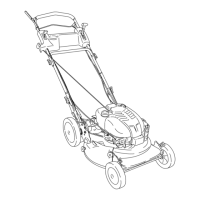
